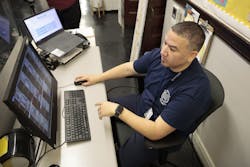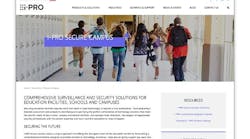A $76.3 million investment will bring new and upgraded surveillance cameras to around 330 schools over the next three years, Chicago Public Schools CEO Pedro Martinez announced Wednesday.
Installed in indoor and outdoor locations, primarily at elementary schools, Martinez said the cameras will, “give security staff greater visibility across all areas of our campuses throughout the school day” and “prove valuable in deterring crime and resolving criminal acts that take place around our schools.”
But while surveillance cameras do have their security benefits, they can contribute to adverse impacts on students, said Odis Johnson Jr., executive director of Johns Hopkins University’s Center for Safe and Healthy Schools.
An education and public health professor, Johnson and research partner Jason Jabbari analyzed U.S. Department of Education data from around 750 U.S. high schools to understand the effects of surveillance on students.
They found students in “high-surveillance” schools are less likely to enroll and persist in college than their peers in schools with low levels of surveillance. Suspensions are also more likely to be doled out among highly surveilled students — regardless of the frequency of student misbehavior at the school. Students at low-surveillance schools also perform better on tests, according to the research, which controlled for a range of demographic, economic, school, household and community characteristics.
“Schools that were in the top third of all U.S. schools in their reliance on surveillance actually had lower academic outcomes in college-going rates compared to those schools that relied on surveillance the least,” Johnson said in an interview with the Tribune. “And this is after making sure that we were comparing apples to apples, that there weren’t any differences in the average student background characteristics, or the average school characteristics, or even the average neighborhood characteristics that kids come from. We wanted to take all of that into consideration to say: Comparing these two approaches to safety, this is what the cost is in terms of learning and college-going.”
And in regards to student privacy, both Johnson and Edwin Yohnka, director of communications and public policy for the Illinois American Civil Liberties Union said at a minimum, parents deserve transparency on details of the district’s plans.
Unlike other contracts in the CPS procurement database, the $76.3 million contract is not publicly navigable. “In order to protect student and staff safety, CPS does not release the specific details of our school safety and security plans,” a district spokesperson said, adding that CPS cameras do not have facial recognition or audio and do not collect biometric data, unlike school cameras that have sparked controversy in other states.
The purchase of school cameras with facial recognition technology prompted new state legislation in New York, which placed a moratorium on the use of facial recognition software in schools, pending further study. Montana legislators also recently met with a school district which adopted the technology that civil rights experts say is prone to errors and biased against people of color.
“At the very least, parents should know that the introduction of surveillance cameras in public schools — regardless of whether facial recognition is used — will be tracking their child’s activities. Parents also need to know that there is no evidence that the use of surveillance in schools will make students or schools safer or feel safer; to the contrary, the use of cameras in classrooms have been found to increase feelings of anxiety and uncertainty among students,” Yohnka said.
Parents should also be engaged in broader discussions involving alternatives, Johnson said. “How else can schools be safer with a $76 million investment in technology?”
During a Chicago Board of Education meeting Wednesday that followed a CPS news conference about the new cameras, board member Elizabeth Todd-Breland questioned Martinez along similar lines, citing a lack of prior discussion regarding the contract.
“Today is the first that I’m hearing about these security camera investments,” she said, asking Martinez to elaborate on the evidence supporting what she called “a big bet” on technologies of surveillance. “What keeps us safe is relationships ... there is a strong evidence base around that.”
Johnson told the Tribune that plentiful evidence shows, “the best way to prevent school violence is to have greater social cohesion, greater or stronger relationships between teachers, parents, and students.”
Martinez said principals raised the need for cameras and challenges regarding a small number of security staff to tackle the large footprint of school buildings. “We have security personnel and they work very hard,” Martinez said. “It’s either one thing or the other. Do we double, triple, quadruple the number of security personnel or do we find ways to better optimize these amazing, dedicated individuals?”
At Eli Whitney Elementary School, where new cameras have been in place since December, Martinez said, “Students understand that this is a deterrent. It’s a way to protect them. It’s a way to make sure that if any suspicious activity outside the school maybe finds its way into the school, it’s a way for us to capture that.”
Principal Evelia Diaz said, in a CPS press release, since installing the cameras, “Our school community has felt an increased peace of mind in knowing that we have another tool to keep students and staff safe.”
But Johnson said the research implies otherwise. When schools double down on surveillance, that doesn’t necessarily communicate safety to students, he said. “We may think as adults that ‘You’re safer. We will be able to respond to any violence more quickly. We’re protecting you.’ But at the same time to kids who are in a system where they come in through the metal detectors ... and then there are cameras everywhere, really what it might communicate to them is: Schools aren’t safe.” And he added, “Being treated like suspects instead of students really undermines the trust that we hope will prevent violence within school contexts.”
All schools need some surveillance — and Johnson considers cameras a standard way of securing an environment. “But if they are not implemented along with a concerted effort to make those kids feel safe, protected, affirmed, trusted ... you’re really setting those security measures up for failure.”
The $76.3 million camera investment is in addition to an annual $8 million budgeted for safety technology equipment. According to a CPS news release, the district spends $3.3 million per year on “proactive safety resources” such as restorative justice and school climate coordinators.
Other student support investments the district announced Wednesday include $5 million in new funding toward social emotional learning curriculum “that includes bullying prevention and other key tactics,” $5 million in additional funding for social workers, $6 million to fund additional school counselors and $13 million toward providing mentorship and mental health supports to students in partnership with the Center for Childhood Resilience at Lurie Children’s Hospital, DePaul University and others.
©2023 Chicago Tribune. Visit chicagotribune.com. Distributed by Tribune Content Agency, LLC.



